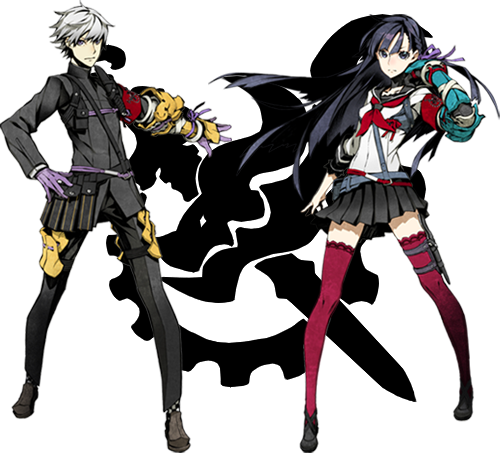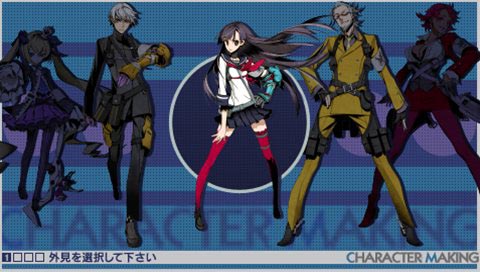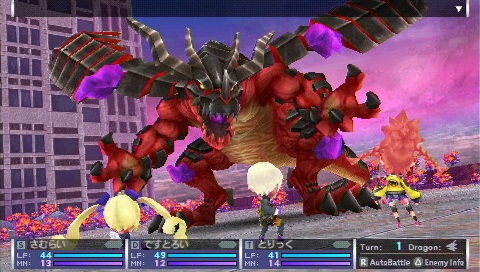Last year I saw Pacific Rim and really enjoyed it. It had kaiju and space aliens and giant robots, what wasn’t there to like? And then earlier this month, I read Hiroshi Sakurazaka’s All You Need Is Kill, which featured aliens and mech suits and weird time loops. Yet another enjoyable story. (The film based off of this novel, Edge of Tomorrow, isn’t too bad either.) It would seem that I’ve hit a theme in my media consumption… This PSP RPG I just finished only followed in this bizarre theme of fighting off alien invasions.
Earlier this month I also started playing a PSP game a friend (who is well acquainted with my particular tastes) had thoughtfully gotten for me over a year ago. The game, called 7th Dragon 2020, shared the fate of many PSP games in that it never left Japan. Published by Sega and developed by Image Epoch, 7th Dragon 2020 is a sequel to the earlier DS game 7th Dragon (which also never left Japan). Whereas the first game in the series was your typical Japanese RPG set in a fantasy, medieval-ish world, 7th Dragon 2020 takes a different approach. The game is set in Tokyo in the year 2020, which means semi-futuristic with a dash of cyber punk here and there. Not many RPGs that I have played go for this kind of setting, so that difference had me interested in the game already.
Add to that the fact that Yuzo Koshiro was doing the music, and my interest was piqued even more. Shirow Miwa of Dogs: Bullets & Carnage fame was responsible for character designs. Another point in the game’s favor. Finally, Kazuya Niinou, director of the first Etrian Odyssey dungeon crawler game, reprized his role of director for this game as well as the one before it. At the very least, I knew that the game had some good people working on it. After having beaten it, I can say that I was not disappointed. Quite the contrary, in fact!
The game’s story starts with dragons from outer space invading Earth. Turns out these dragons’ favorite snack is people. Despite the game being set in modern times, the plot is about as ridiculous as in any other RPG. It’s one thing I really love about this game.
The player takes the role of the 13th Murakumo Squad (anti-dragon special forces) and starts the game by choosing from 5 classes to make a 3-person team. Since this game is set in semi-futuristic Tokyo, regular classes like Swordsman, Thief, Mage, etc. wouldn’t really work. Instead, you get the likes of the Samurai, Trickster, Psychic, Destroyer, and Hacker. The Samurai class is pretty much a Swordsman, while the Trickster is kind of like a Thief with access to status ailments. Psychics are mages who have attack spells and healing. Destroyers are monks but also have high defense, which makes them tank-like. Finally, the Hacker has buffs and debuffs. Since the game cuts down on the number of classes, it does its best to keep each class balanced. There’s really no bad combination of classes that the player can pick, in other words. I ended up going with Samurai (male), Trickster (male), and Psychic (female).
Another interesting feature is the ability to choose a voice actor for the characters you create. I’m not super well-versed in Japanese voice actors, but I have a few favorites, so naturally I ended up picking Takahiro Sakurai (for Samurai) and Tomokazu Sugita (for Trickster). For my female Psychic, I picked Toyoguchi Megumi.
As for the visual style in the game itself, it uses a weird miniature style that’s reminiscent of the nendoroid figures popular in Japan right now. It’s a bit weird at first, but I was able to get used to it rather quickly. For the most part, the in game models reflect the character designs. The proportions are just a lot different. The style reminds me of a more deformed version Bravely Default‘s in-game models.
The game’s battle system is traditional turn-based battle with a 3-person party. The player can make more than 3 characters, of course, but that leads to juggling party members and keeping everyone’s levels up. I didn’t want to do that, so I stayed with my three. Thanks to how well the game is balanced, I never really found that my team couldn’t handle any particular enemy or boss. Proper strategizing allowed me to get through just about everything.
So how does one go about liberating the world from vicious space dragons? Bit by bit, it turns out. Like in any RPG, the game has the player progress through a series of dungeons. The part I found amusing was that all of these dungeons are locations in Tokyo. In fact, I think every dungeon is a stop on the Yamanote Line. You start out by liberating the Tokyo Metropolitan Government Building in Shinjuku, which then serves as a base of operations from then on. Other areas featured in the game are Shibuya, Ikebukuro, Yotsuya, Kokubunji, and so on. The game does an odd twist on post-apocalyptic Tokyo by giving each area a theme (there’s a desert, jungle area, frozen over area, and so on).
The game also features some town-building in that you get to repair floors in the Tokyo Metropolitan Government Building. You don’t get to customize anything, but you can pretty much choose what order in which to upgrade the building. I really enjoyed this feature of the game since you got bonuses from fixing or upgrading each floor.
In terms of difficulty, this game wasn’t too difficult. I actually found it surprisingly easy until a difficulty spike at Yotsuya’s dungeon. Much like in Etrian Odyssey games, more powerful enemies (dragons, in this case) are visible on the map and serve as obstacles to the player. Unlike Etrian Odyssey, however, fighting these dragons is generally a good idea since they provide a special kind of currency used in town-building. The game also gives a Retry option upon getting a Game Over, which really surprised me. That alone saved me a ton of time in later parts of the game. It seems that the director wasn’t going for as much of an old school feel as the Etrian Odyssey series did.
There’s a sequel called 7th Dragon 2020-II that came out last year that I’m really looking forward to getting and trying out now that I’ve finished this game. I suppose the part of the game that appeals to me most has to do with the modern setting, which a lot of RPGs don’t feature. The game’s unique classes offer a nice twist on common RPG staples. The one RPG I can think of that this game most reminds me of is The World Ends With You by Square Enix. The two games feature somewhat similar settings and design aesthetics. TWEWY also had some interesting twists on traditional RPG mechanics.
As for recommending this game, well… it’s always hard for me to recommend a game that hasn’t been translated into English. It can be really frustrating to play a game in a language that you aren’t fluent in. Even with my 4+ years of Japanese experience, I probably spent a good proportion of my time playing this game looking up kanji. I’d say I was able to understand maybe 60-70% of the story just from reading, which was enough to get a decent handle on the story. If you don’t mind playing import games and you have a functioning PSP lying around, I’d definitely recommend this. If you’re not much for that kind of thing and hate following translation faqs, then I can’t really recommend this game.
Another thing I noticed about this game was that it seemed to be pretty much focused on male fans. There’s a male and female variant for each class, but the cover of the game pretty heavily favors the female characters. In terms of design, I didn’t find the female characters to be too outrageously fanservicey with one exception I won’t bother mentioning here. But what gets me is that Good Smile Company made statues of various characters of the game, and so far it’s only female characters! Some of the male character designs are good, too. And they haven’t even made a statue of my favorite female design in the game, which is another major bummer. An unfortunate reality when dealing with the video game industry, unfortunately.
Oh, and Hatsune Miku makes an appearance in this game. Why? Because of marketing, I assume.




